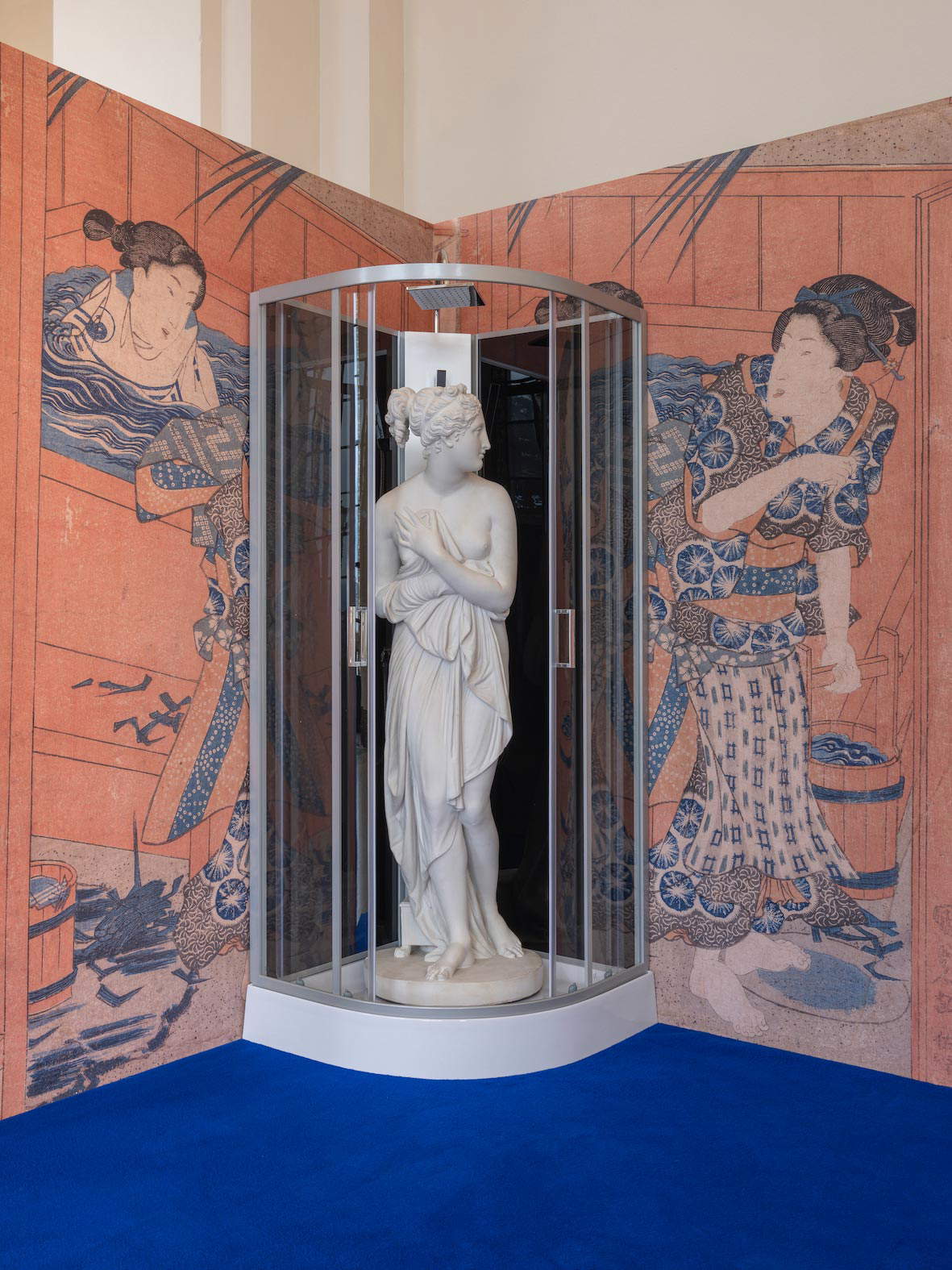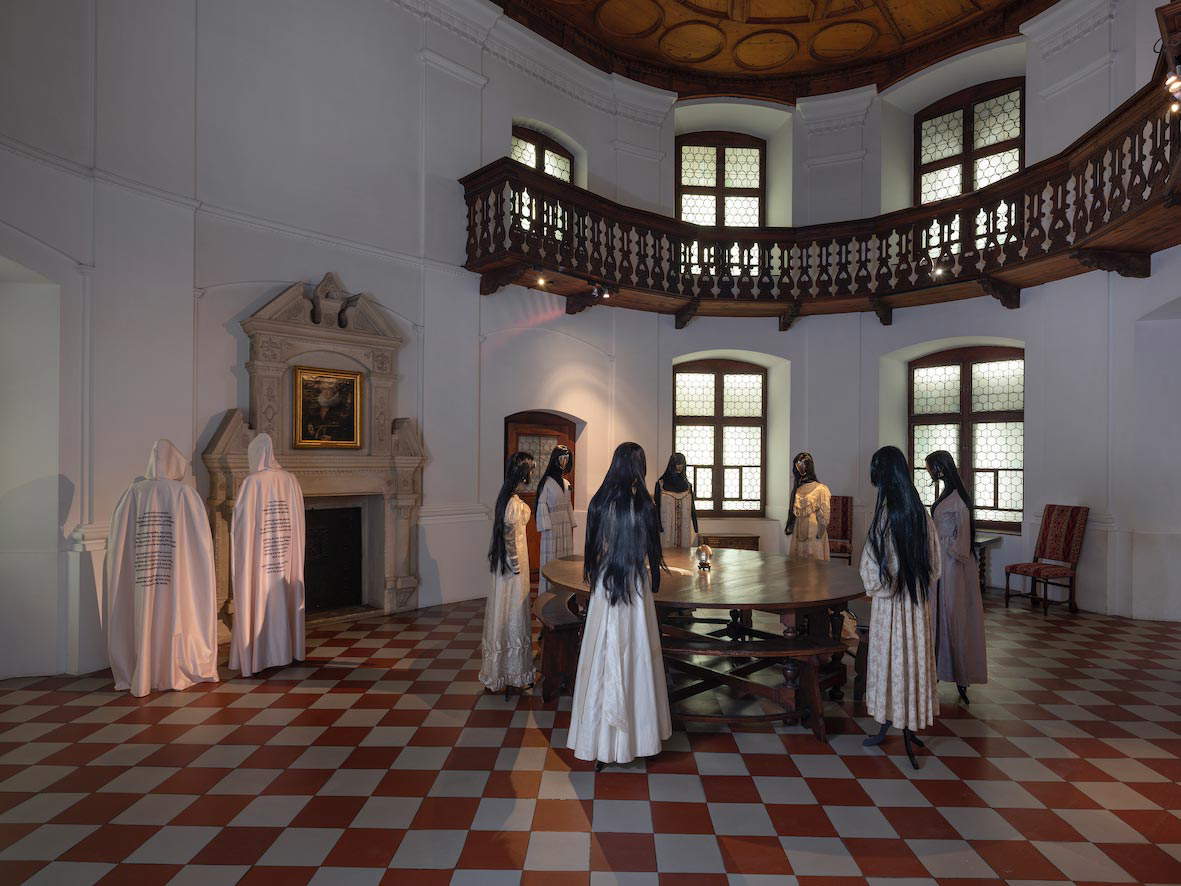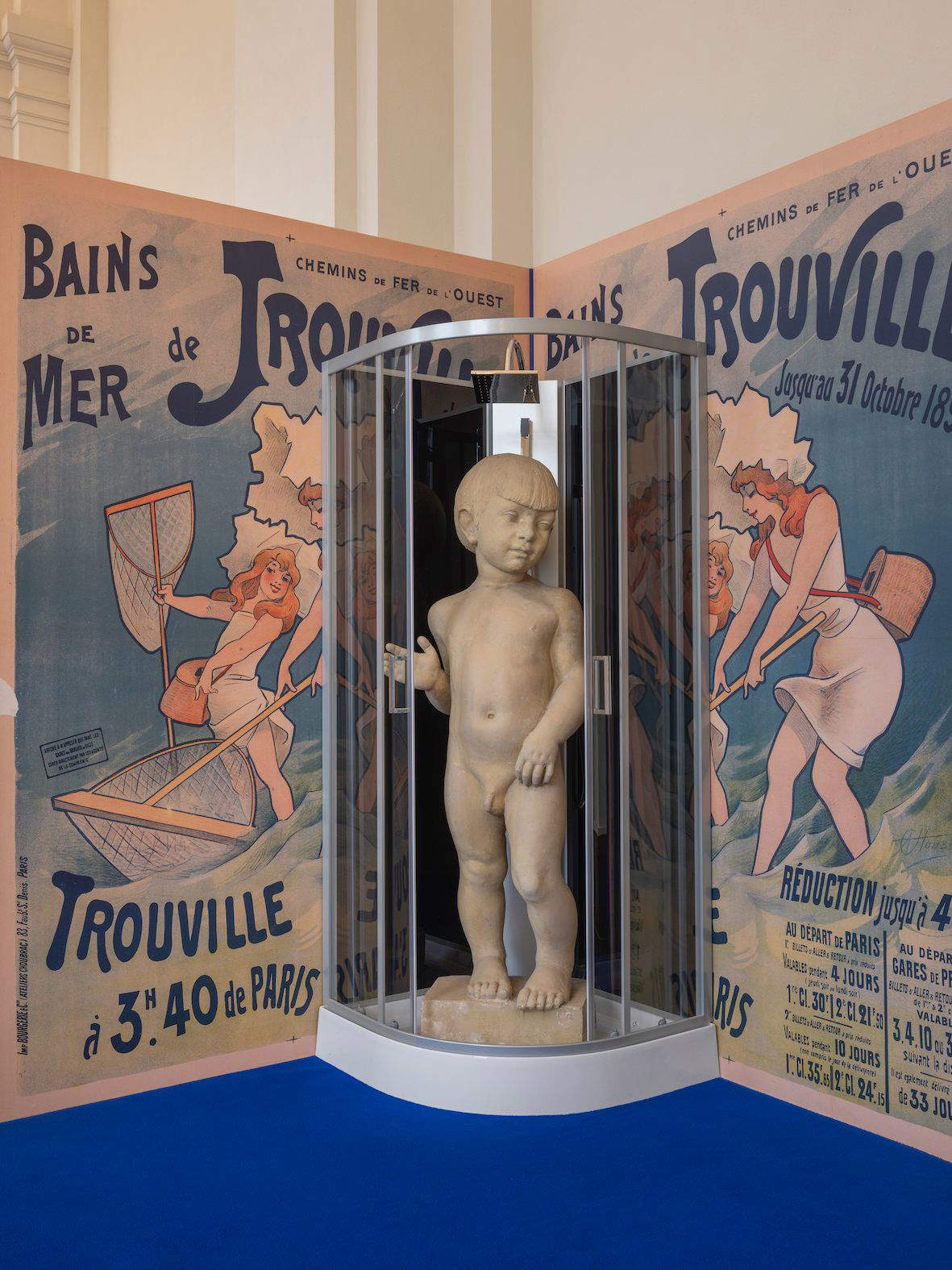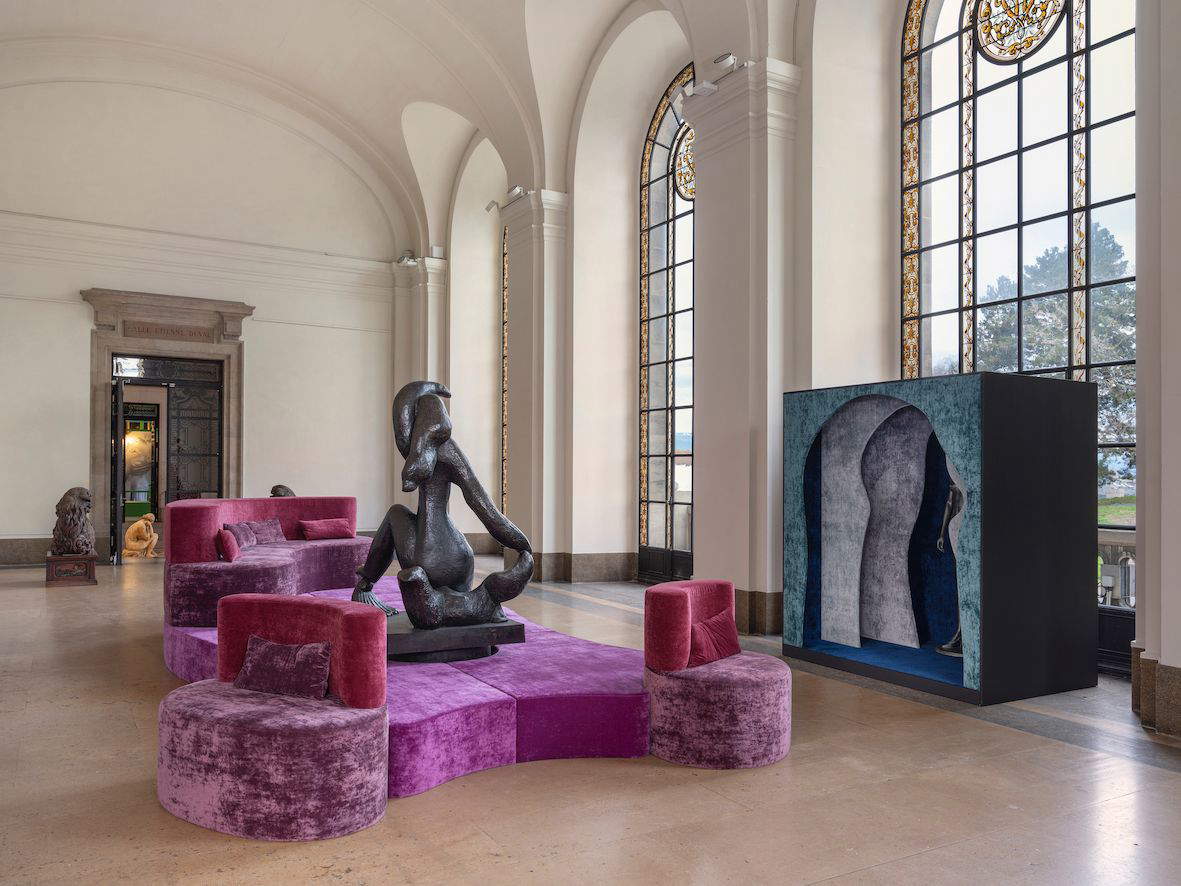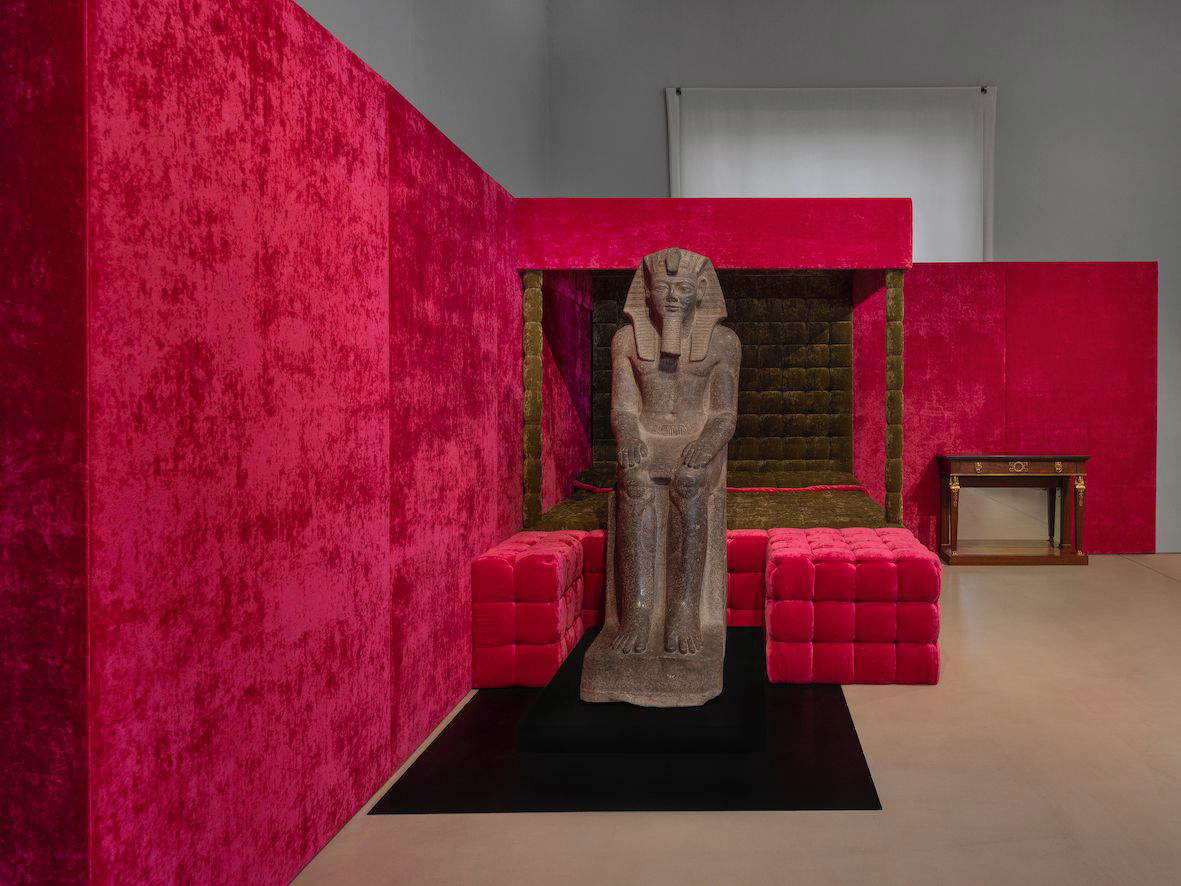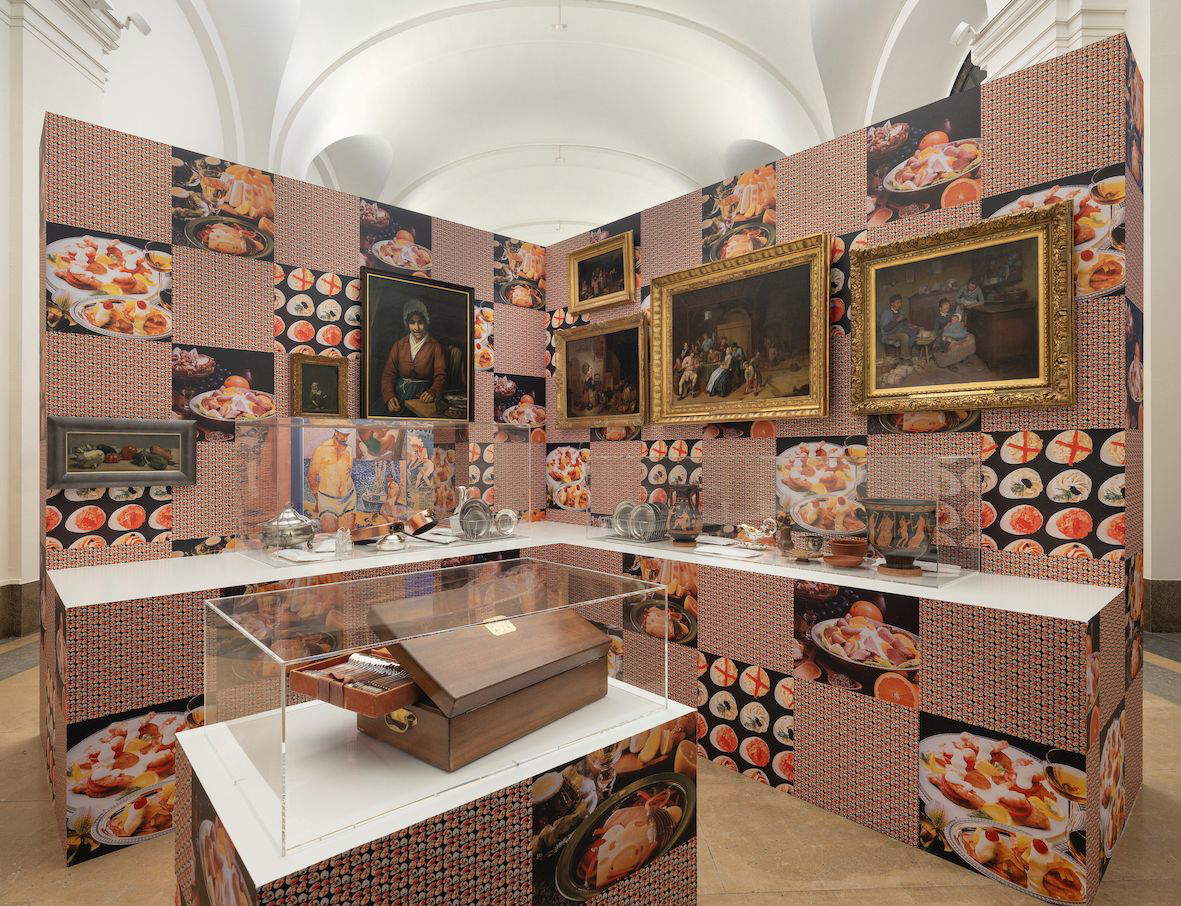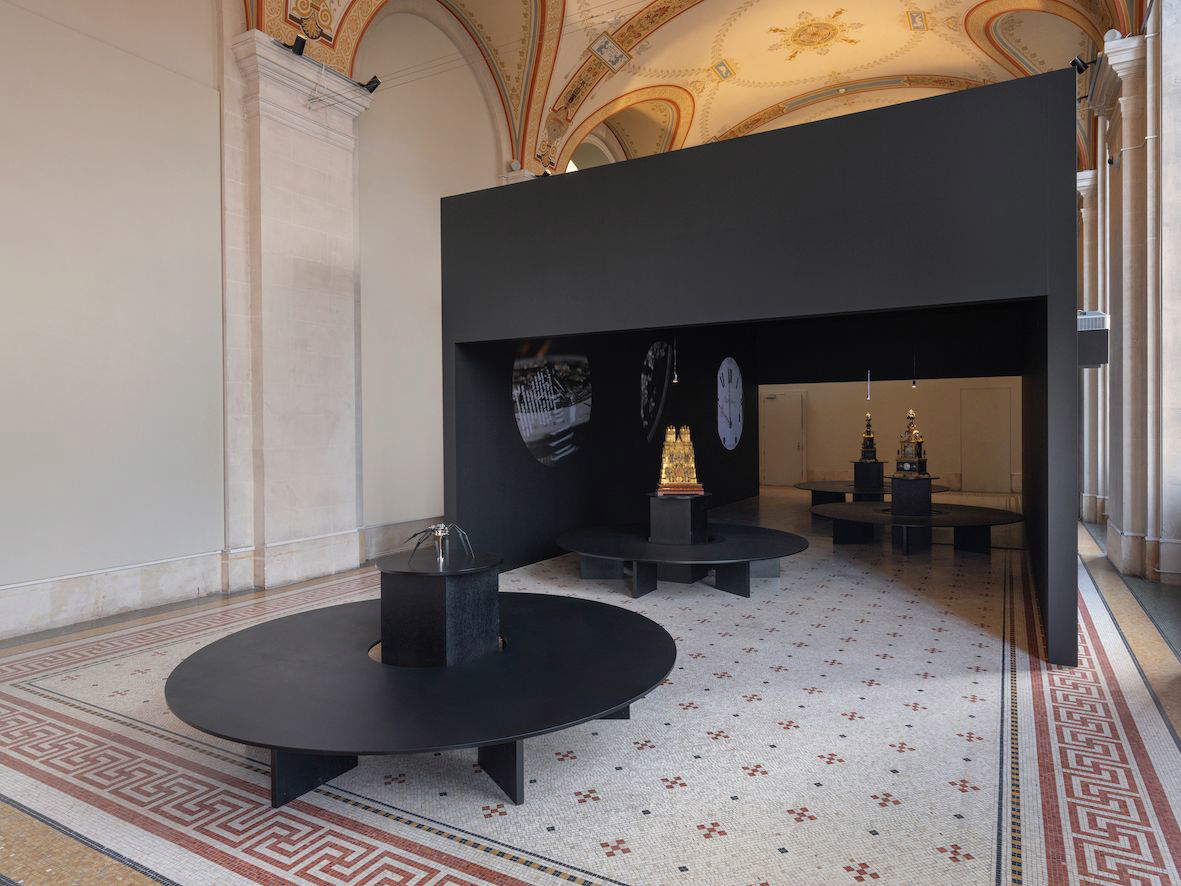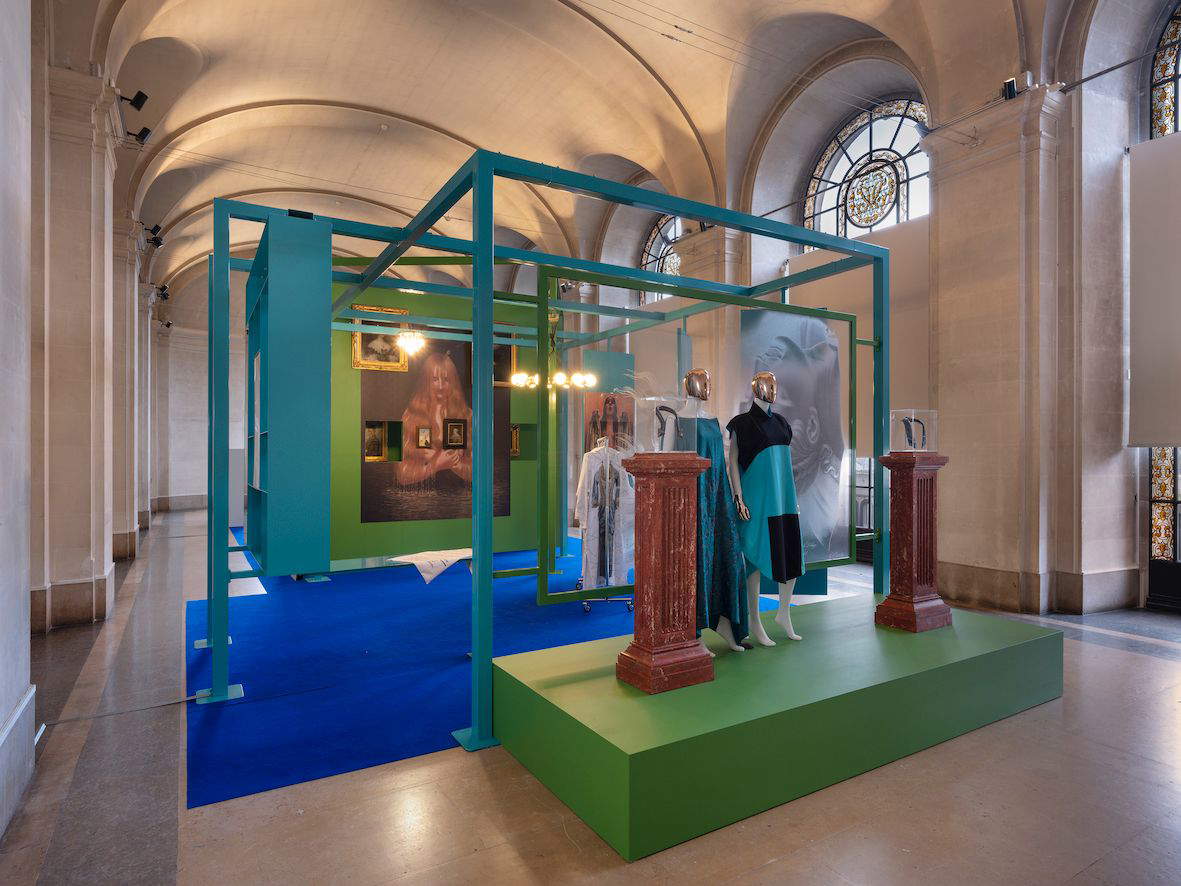by Redazione , published on 02/03/2021
Categories: Exhibitions
/ Disclaimer
Museums are reopening in Switzerland, and a bizarre exhibition, curated by Austrian artist Jakob Lena Knebl, is being staged at the Musée d'Art et d'Histoire in Geneva, which promises to shift paradigms and introduce new points of view on works that are familiar to us.
Neoclassical statues inside shower stalls, Egyptian antiquities on Hollywood beds, paintings hanging on prefabricated wooden cottages: these are some of the scenarios that the Marcher sur l’eau exhibition brings to the Musée d’Art et d’Histoire (MAH) in Geneva. The exhibition inaugurating the Swiss museum’s new direction opens today, March 2, 2021, and runs through June 27: curated by Viennese artist Jakob Lena Knebl, who will represent Austria at the Venice Biennale in 2021, Marcher sur l’eau displays a conspicuous selection of objects from the museum while radically rethinking the way works from the past are displayed. The title refers, on the one hand, to Konrad Witz’s 15th-century Miraculous Peach, which features the figure of Christ walking on the waters of Lake Geneva at its center (the work is part of the exhibition’s itinerary), and, on the other, to Deep Purple’s celebrated song Smoke on the water, which recounts the 1971 Casino de Montreaux fire. These are the chronological extremes of the selection.
The clash of cultures is one of the pivotal elements of Knebl’s artistic practice, which in his works combines design, pop culture and references to the “great” history of art: a practice that is now declined in the curatorial sphere to create an exhibition that aims to abolish hierarchies, erase the boundaries between low and high culture, engage visitors by leading them to build bridges between themselves and the objects on display, and explore with a sense of humor the concepts of identity and body. The exhibition thus becomes a kind of artist’s playground, tasked with choosing from the thousands of objects stored in the museum’s collection (including archaeological finds, tapestries, paintings, sculptures, jewelry and more) to create unusual and surprising associations. Visitors themselves are prompted to interact with the installations: they can sit on a foam couch presented as a “soft sculpture,” they can wear clothes hanging in an installation that recreates a real clothing store, they can photograph “pre-censored” sculptures of nudes and post them on social media without incurring penalties.
The exhibition, the artist explains, is inspired by a short story by Jorge Luis Borges, There are more things from 1975, a work whose title comes from Shakespeare’s Hamlet and in which a random chain of events brings the narrator himself to an extravagant house filled with impossible-to-define objects, a perspective that frightens him: only by changing the way he sees things will he be able to understand what he is observing and confront the master of the house. The moral of this story, Knebl says, is to be found in the protagonist’s confusion: the preconceived ideas we have prevent us from seeing things out of their contexts. Thus, Knebl invites visitors to the Musée d’Art et d’Histoire in Geneva to leave their preconceived ideas at the door and to “walk on water,” or at least to change their point of view about the objects around them: "Marcher sur l’eau,“ he says, ”is a reference to the moment when we try something for the first time: will it work or not? Will we be able to walk on water?"
 |
| Exhibit set-ups Marcher sur l’eau. Ph. Credit Julien Gremaud |
 |
| Installations of the Marcher sur l’eau exhibition. Ph. Credit Julien Gremaud |
 |
| Jakob Lena Knebl. Ph. Christian Benesch |
“An exhibition to introduce new perspectives on works that are familiar to us.”
The museum has been working on the exhibition for some time: Knebl visited the museum and its spaces in February 2020, and all of the work was followed up during the months of the Covid-19 pandemic, partly from a distance and partly with a number of site visits to the museum, during which the Austrian artist worked to compose her selection. “My commitment to the museum’s collection,” she explained, “is based on a very personal approach, developed through the eyes and method of an artist. I am interested in the impact on us of the things that surround us and, in a way, how they become part of ourselves: spaces and products that throttle us, challenge us, lead us astray. For me, an easily accessible approach is important, because then we can appeal to people who weren’t interested in art and design before.”
“Art, design and everyday objects,” Knebl adds, “have an equal position in the spaces I create. I dissolve the distance by separating them and connecting them to each other. Art becomes a showcase for design and vice versa. My goal is to build spaces that seduce, that introduce new perspectives on the works we are familiar with and ways of reading them, to arrive at a presentation that transgresses museum rules. For this exhibition, which I organized in collaboration with the MAH curators, I used different tactics: humor, inversion, fetishism, paradoxes, the unexplained and the familiar. When we visit an exhibition, we first look at the things we know, that are familiar to us. For my set design, I worked on the way the works in the collection are presented. I like to blur the line between public and private, and to achieve this, my set designs are inspired by interior design: I can see a Vallotton painting in my kitchen, I can lie on my bed with a monumental Egyptian sculpture, and that’s how I get lost in time.”
 |
| Marcher sur l’eau exhibition installations. Ph. Credit Julien Gremaud |
 |
| Marcher sur l’eau exhibition set-ups. Ph. Credit Julien Gremaud |
 |
| Installations of the exhibition Marcher sur l’eau. Ph. Credit Julien Gremaud |
 |
| Installations of the exhibition Marcher sur l’eau. Ph. Credit Julien Gremaud |
 |
| Installations of the exhibition Marcher sur l’eau. Ph. Credit Julien Gremaud |
The route and sections of the exhibition
The exhibition begins even before visitors enter, as even the cabinets used to leave objects are part of the same exhibition and become the protagonists of an installation. The welcome is entrusted to a plaster statue by Carl Angst, entitled Recueillement, on which the title of the exhibition is projected by means of a laser usually used for the restoration of sculptures. The first room(AMAM - Cuisine et salle de bain) is centered on the theme of bodily hygiene, and here some sculptures are...showering: a plaster cast by Antonio Canova ( Venus Italica), one by James Pradier(Venus at the Bath) and yet another by Roger Ferrier depicting a standing child, are placed inside shower stalls. Behind them are large-scale reproductions of posters and japonaiserie (such as Henri Edmond Cross’s Le Lesteur ). The second part of the room takes on the appearance of an ultra-modern kitchen where silverware, crystal bottles, antique ceramic vessels, as well as seventeenth-century Dutch genre scenes on the theme of food find their place.
The MAH’s large Armor Hall, on the other hand, has been transformed into a garden where a number of prefabricated wooden cottages have been installed: inside are ancient artifacts waiting to be restored, while antique paintings with bucolic themes (which, Knebl points out, could be described as typically Swiss: bouquets of flowers, cows grazing on alpine pastures, and so on) have been hung on the exterior walls. The Hall of Honor of Zizers Castle (so named because it normally houses the reconstruction of the castle’s namesake), has been transformed into the “Séance” (“the séance”): six mannequins in white robes gather around a large table in a séance. The dresses are from different eras: from a 19th-century satin and tulle dress to contemporary creations by Yves Saint-Laurent and Pierre Balmain. Still, the room of Egyptian collections hosts the “Sommeil et mort” (“sleep and death”) section: transformed into a Hollywood-style bedroom, the room sees the colossal statue of Ramses II installed in a comfortable bed and surrounded by various objects. Knebl, who recalls how the work, after its discovery in 1889, had been used for propaganda purposes, now invites the pharaoh to “sleep the sleep of the righteous, winking at the cult of the dead in his home country.”
In the Medieval Hall, on the other hand, the Lumières dans les coulisses section is staged, which aims to pay tribute to all those who work behind the scenes in museums: a number of crystal and metal lamps are thus displayed in the wooden crates that are usually used to transport them. The second palatial hall houses the Chambre noire, where the visitor will find two cubic structures: the first houses some works arranged within large niches concealed from view because of their erotic content or because of their controversial character (they are works by Swiss painter �?mile Chambon), in a setting intended to refer to the limitations reserved for “adult audiences.” The second cubic structure, on the other hand, contains a gallery where visitors can listen to the first notes of Pink Floyd’s Time on a loop and where they can see a small selection of clocks on rotating platforms-the theme, of course, is time.
The small Palatine rooms, on the other hand, are dedicated to the theme of body with the section Membres manquants (“Missing Parts”), which proposes to compensate ancient statues for their missing parts, precisely. In the hall, the amputated limbs of ancient statues are reborn thanks to the facetious spirit of Jakob Lena Knebl, who imagines them in a textile version with pop connotations. Moving on, the first palatial hall has been transformed into the Boutique Jeanne, a room devoted to the theme of the body and clothing: thus, a fashion boutique appears to the visitor where all styles and eras meet. There are mannequins, selections of necklaces, footwear, but also works by Jacques-Laurent Agasse, Carlos Schwabe, and Anne-Louis Girodet. Also available to visitors are clothes specially designed by Knebl and vintage pieces that can be purchased in the boutique (which is therefore also a real store). In this case, for conservation reasons, the selection of objects will change while the exhibition is in progress. The last section is called Censure in situ, which refers to something that happened last year at the Musée d’Art et d’Histoire in Geneva, which was censured by Facebook for publishing an antique nude as part of activities to promote the exhibition César et le Rhône. Chefs-duvre antiques dArles. The installation envisioned by Knebl to conclude the exhibition makes sure to deliberately hide the intimate parts of the ancient statues, and invites visitors to take “pre-censored” photographs that they can then share on social media without any problems. Those who want to learn more can visit the website of the Musée d’Art et d’Histoire de Genève.
 |
| Exhibit set-ups Marcher sur l’eau. Ph. Credit Julien Gremaud |
 |
| Set-ups of the Marcher sur l’eau exhibition. Ph. Credit Julien Gremaud |
 |
| Installations of the exhibition Marcher sur l’eau. Ph. Credit Julien Gremaud |
 |
| Installations of the exhibition Marcher sur l’eau. Ph. Credit Julien Gremaud |
 |
| Installations of the exhibition Marcher sur l’eau. Ph. Credit Julien Gremaud |
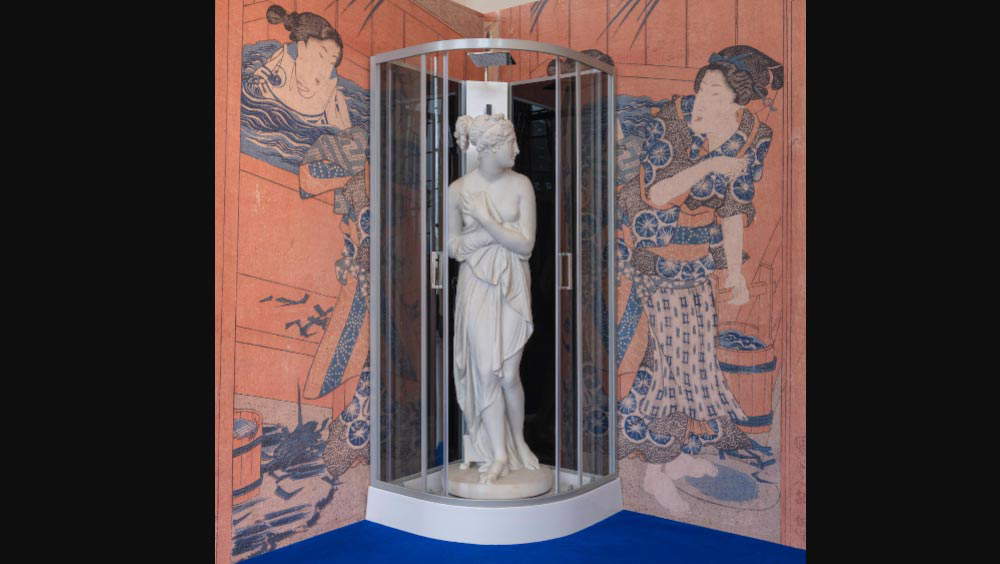 |
| Statues inside shower stalls and paintings on wooden cottages. Paradigm-shifting exhibition in Geneva. |
Warning: the translation into English of the original Italian article was created using automatic tools.
We undertake to review all articles, but we do not guarantee the total absence of inaccuracies in the translation due to the program. You can
find the original by clicking on the ITA button. If you find any mistake,please contact us.
